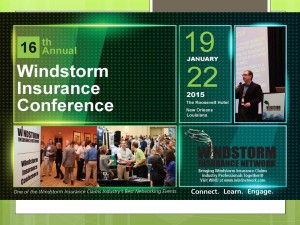
Kimberly Sands, a partner with Upchurch Watson White & Max, has been a civil litigator and has been involved with difficult and complex disputes as litigator or mediator for over 30 years. To schedule a mediation with Kimberly, please call her case manager, Cathy McCleary, at (800) 863-1462, or visit our online calendar.
I recently had the great pleasure of joining Donna DeVaney Stockham, a principal with Stockham Law Group, and Michael Parker, a shareholder in the law firm of Marshall Dennehey Warner Coleman & Goggin, in a panel discussion titled “Return to Civility: How to Communicate More Effectively in Today’s Professional Environment.” The presentation was made at the annual WINDSTORM Conference, this year in New Orleans, La. WINDSTORM Insurance Network, Inc., is a professional organization dedicated to providing education and training and promoting a cooperative dialogue among professionals concerned with first party property insurance issues.
The presentation included animations and videos of actual depositions as well as written communications between attorneys, insurance representatives, and other insurance professionals illustrating bad behavior. The panel discussed the possible motivations behind such behavior, ways to respond to it, and how to avoid becoming an unwilling participant. The intent was to make the presentation entertaining but also demonstrate how incivility interferes with effective communication and representation.
In the videotaped depositions the interaction between attorneys goes from heckling objections to fisticuffs in front of deponents whose reactions run from bemusement to boredom. We discussed whether the bad behavior was unethical; whether it was intentional and if so what was the objective; and finally, what could the responding attorney do differently? In the example videotapes opposing counsel tried either to reason with the instigator or joined in the chaos. Both tend to muddy the record for the judge or magistrate asked to resolve the dispute, resulting in dissatisfaction with the conduct of all participants.
In another example, a series of cooperative emails seeking to schedule mediation went wildly off course when the insurer requested an inspection before mediation and the claimant’s counsel objected on the grounds it was too close to trial. Both sides dug their heels in, seemingly without discussing “why,” or “how can we make this work?” As a mediator, I’ve settled these disputes without bloodshed and to the satisfaction of all. The key is communication.
The takeaway for practitioners is, unless you’re trying to become a viral sensation on YouTube, always behave as if a judge or jury is watching. Think about your goals and objectives and the goals and objectives of your opponent; think how what you say or do may or may not be effective; and think how your conduct will be judged in hindsight by disinterested third parties. If you assume all bad behavior is calculated to achieve a certain response, you may think before you respond. If your inclination is to behave badly, check your motivation, consider the possible outcomes, and proceed in a manner consistent with effective advocacy and the standards of our profession.
Ms. Sands will next speak for the Florida Justice Association’s Workhorse Seminar at the Renaissance Orlando Resort at Seaworld. Her presentation begins at 7:30 p.m. Wednesday, Feb. 18. For more details, please click here.
